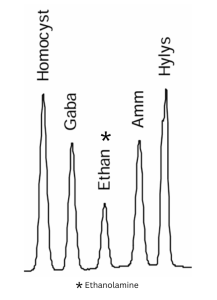Ethanolamine Analysis for Cell Culture Optimisation in Cultured Meat
As the cultured meat industry moves away from fetal bovine serum (FBS), there is growing demand for serum-free and chemically defined media that can reliably support cell growth and differentiation. This transition is driven by the high cost of FBS, its variability between batches, and ethical concerns related to its use. [1] However, replacing serum is not a simple process. Each component must be carefully selected and adjusted to suit the needs of specific cell lines used in cultured meat production.
To achieve consistent performance, researchers are focusing more closely on smaller media components that influence cell behaviour. Ethanolamine, a simple aminoalcohol, plays a key role in membrane formation, mitochondrial function and overall cell metabolism. Although it is often overlooked in standard formulations, its presence and precise concentration may affect cell growth. Precise ethanolamine analysis supports the optimisation of cell culture media for improved performance and consistency and is included in the amino acid analysis service offered by AltaBioscience.
Ethanolamine and Cell Function
Ethanolamine is a key precursor for phosphatidylethanolamine (PE), a major phospholipid in animal cell membranes, especially within the inner mitochondrial membrane.[2,3] PE supports membrane integrity, mitochondrial function, and protein folding. It also promotes cell proliferation by activating pathways such as mTOR and regulating cell cycle proteins,[4] making it highly relevant for high-density cultures in cultivated meat production.
While fetal bovine serum supplies ethanolamine naturally, chemically defined and serum-free media require it to be added directly.[5] Certain studies showed that ethanolamine is essential for cell growth of hybridomas in serum-free media, particularly alongside insulin, transferrin and selenium.[6,7] Supplements now routinely include it to support membrane formation and cell viability.
In cultured meat applications, ethanolamine may support critical functions such as mitochondrial activity and membrane synthesis. Its role as a phosphoglyceride precursor is central to maintaining cell structure and metabolism.[8] While its impact may vary depending on media context, it could offer greater benefit when combined with other components.[9] Therefore, to evaluate its role effectively, ethanolamine must be accurately quantified.
Ethanolamine Analysis in Animal-Free Medium
To optimise media formulations and enhance cell performance, it is essential to monitor ethanolamine concentrations in both fresh and spent media throughout the culture process. Ethanolamine analysis provides insight into nutrient utilisation rates, helping researchers identify whether current supplementation levels are sufficient or require adjustment. This data-driven approach supports more effective media development, allowing for improved cell growth, viability, and metabolic efficiency.
Although ethanolamine is not classified as a standard amino acid, it contains a primary amine group, which allows it to be detected and quantified using amino acid analysis. This is typically achieved through derivatisation with ninhydrin, a reagent that reacts with free amines to produce a coloured compound. As a result, ethanolamine can be reliably measured alongside proteinogenic amino acids using ion-exchange chromatography followed by HPLC detection.

Our ISO/IEC 17025:2017 accredited testing service offers comprehensive amino acid profiling that includes ethanolamine analysis. This allows for simultaneous quantification of ethanolamine and standard amino acids in culture media, providing a detailed picture of nutrient availability and cellular demand. Whether in early-stage research or process-scale manufacturing, this data is valuable for optimising feed strategies, validating batch consistency, and refining serum-free or chemically defined media formulations.
This analytical approach helps ensure that ethanolamine supplementation is neither limiting nor excessive, contributing to better experimental reproducibility and more robust culture outcomes in cellular agriculture.
Conclusion
As the cultured meat industry shifts toward serum-free and chemically defined media, understanding the role of individual components like ethanolamine becomes increasingly important. Ethanolamine contributes to essential cellular functions with its presence in optimised media formulations supporting improved cell growth, viability, and differentiation.
Accurate quantification of ethanolamine through amino acid analysis provides researchers with critical insights into nutrient consumption. This data enables fine-tuning of media formulations, enhances batch consistency, and supports the development of scalable, reproducible culture systems. By integrating ethanolamine analysis into routine media optimisation workflows, the cultured meat sector can make informed decisions that drive both scientific progress and commercial viability.
To learn more about how our amino acid and ethanolamine analysis services can support your cell culture media optimisation projects, contact info@altabioscience.com today.
References
[1] Gomez Romero, S., Spielmann, I. and Boyle, N., 2025. Genome-scale metabolic models in cultivated meat: advances, challenges, and future directions. Current Opinion in Biotechnology, 94, p.103313. https://doi.org/10.1016/j.copbio.2025.103313
[2] Patel, D. and Witt, S.N., 2017. Oxidative Medicine and Cellular Longevity, Article ID 4829180, https://doi.org/10.1155/2017/4829180
[3] Tasseva, G., Richard, L., Zacharia, J., Da Costa, K.A., Zeisel, S.H. and Song, J., 2013. Phosphatidylethanolamine deficiency in mammalian mitochondria impairs oxidative phosphorylation and alters mitochondrial morphology. Journal of Biological Chemistry, 288(6), pp.4158–4173, doi: 10.1074/jbc.M112.434183
[4] Yang H, Xiong X, Li T, Yin Y. Ethanolamine enhances the proliferation of intestinal epithelial cells via the mTOR signaling pathway and mitochondrial function. In Vitro Cell Dev Biol Anim. 2016 May;52(5):562-7. doi: 10.1007/s11626-016-0002-8. Epub 2016 Mar 22.
[5] Lee DY, Lee SY, Yun SH, Jeong JW, Kim JH, Kim HW, Choi JS, Kim GD, Joo ST, Choi I, Hur SJ. Review of the Current Research on Fetal Bovine Serum and the Development of Cultured Meat. Food Sci Anim Resour. 2022 Sep;42(5):775-799. doi: 10.5851/kosfa.2022.e46. Epub 2022 Sep 1.
[6] Kovář, J., and Franěk, F. (1984). Serum-free Medium for Hybridoma and Parental Myeloma Cell Cultivation: a Novel Composition of Growth-Supporting Substances. Immunol. Lett. 7 (6), 339–345, https://doi.org/10.1016/0165-2478(84)90092-0
[7] Murakami, H., Masui, H., Sato, G.H., Sueoka, N., Chow, T.P. and Kano-Sueoka, T., 1982. Growth of hybridoma cells in serum-free medium: Ethanolamine is an essential component. Proceedings of the National Academy of Sciences, 79(4), pp.1158–1162. doi: 10.1073/pnas.79.4.1158
[8] Kolkmann, A.M., Van Essen, A., Post, M.J. and Moutsatsou, P., 2022. Development of a chemically defined medium for in vitro expansion of primary bovine satellite cells. Frontiers in Bioengineering and Biotechnology, 10, p.895289, https://doi.org/10.3389/fbioe.2022.895289
[9] Stout, A.J., et al. Simple and effective serum-free medium for sustained expansion of bovine satellite cells for cell cultured meat. Commun Biol 5, 466 (2022), https://doi.org/10.1038/s42003-022-03423-8



